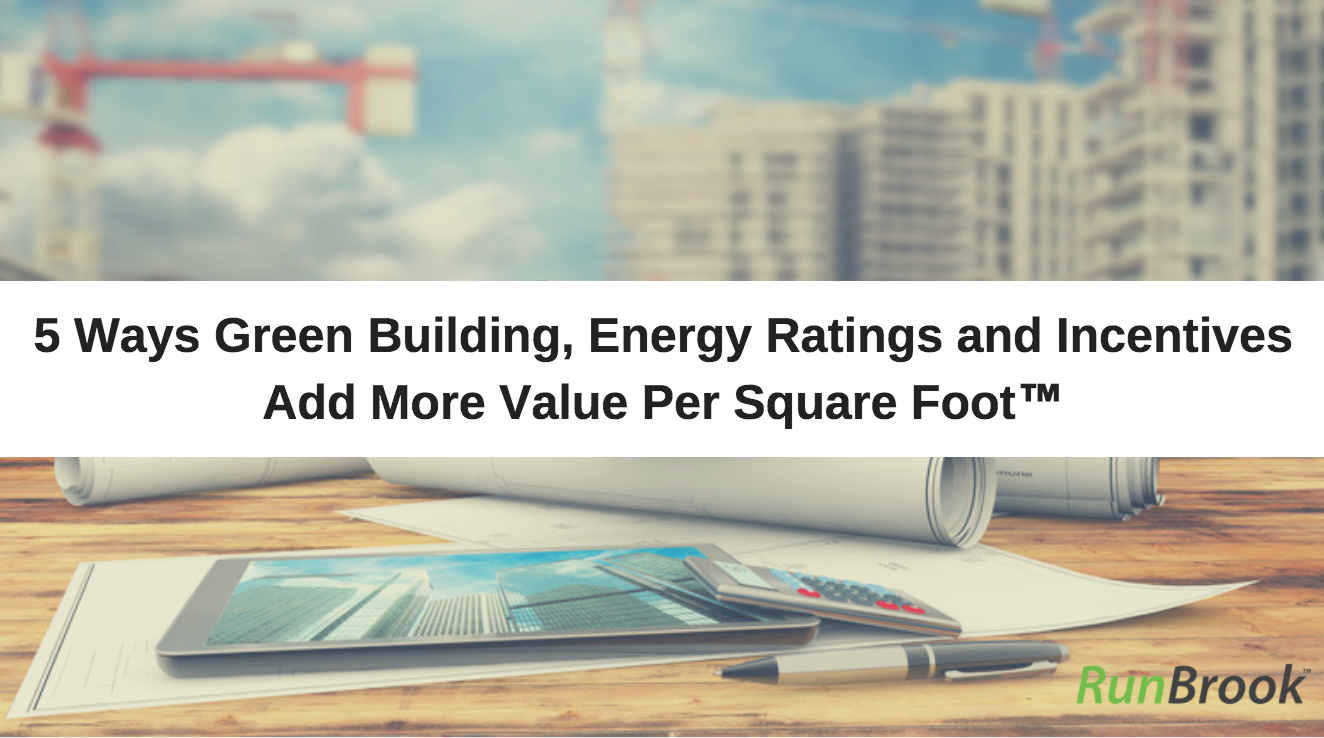By Matt Zirkelbach, Co-Founder and President, RunBrook
At RunBrook, we help our customers take advantage of green building programs and technologies, better understand building performance through energy ratings and capitalize on financial incentives for meeting above-code standards. Our mission is to create More Value Per Square Foot™ for our multifamily and production home customers by improving building performance and the bottom line.
Based on our decades of industry experience, here are the top 5 ways that green building, energy rating and incentive services add more value:
1) Meet Regulatory Requirements
Meeting regulatory requirements is the most basic and important benefit. In Florida, as in many other states, there are state and municipal-level requirements that residential units or homes meet certain energy and/or green building standards. For example:
- At the state level, as of July 1, 2017, the Florida building code requires blower door testing for all new residential homes and multifamily buildings three stories or less.
- At the municipal level, The City of Miami’s “Miami 21” zoning code requires all new buildings of 50,000 square feet of habitable rooms or space in certain zones to attain a LEED Silver certification from the United States Green Building Council (USGBC). If the buildings don’t meet the requirement, a performance bond of up to four percent of the total cost of construction is forfeited to the City of Miami. However, if the buildings do meet or exceed the requirement, in addition to recouping the bond amount, the builder may be given additional capacity.
RunBrook’s specialists have helped thousands of residential units and homes meet these types of regulatory requirements.
2) Lower Operational Costs
Another value is lowering a building’s operational costs. Through the green building certification process, energy modeling, conducting energy audits, conducting home energy ratings and making recommendations on how to improve efficiency and durability, RunBrook’s clients have significantly reduced utility bills, waste-output related costs and maintenance expenses.
These efforts can result in millions of dollars saved over time, especially when a developer continues to maintain common areas. The cost savings can also be attractive to potential buyers of a development, as well as renters and owners.
3) Increase Durability and Lower Risk
An often overlooked, but important, value of green building is the ability to reduce risk. Green buildings go through comprehensive durability and performance testing to become certified, and, as a result, tend to suffer fewer losses and are often safer to finance and insure.
For example, during the certification process, RunBrook’s specialists review building plans and monitor construction to check that building systems, including lighting, heating and air conditioning, are installed and operating correctly and safely. This additional attention to durability can help prevent future losses and offer hedges against changing consumer demands, new laws and increasing utility prices. For these same reasons, underwriters and insurers often see green buildings as better candidates.
4) Benefit from Financing and Tax Incentives
Sustainable building practices boost value when clients benefit from special financing and tax incentives. Through green building, consulting, building energy models and utility data tracking, RunBrook has helped builders meet the requirements of financing incentives.
One example is the Federal Housing Administration (FHA)’s Mortgage Insurance Premium (MIP) reduction program that provides mortgage insurance premium discounts to properties that: 1) Are green certified, 2) Meet specific energy-efficiency targets and 3) Meet ongoing operational energy-efficiency objectives.
Complimentary assessments can also help determine whether projects qualify for tax incentives, such as the EPAct 179D tax deduction for HVAC, lighting and envelope improvements, or the 45L Energy Efficiency Home tax credit for residences that meet certain energy savings requirements.
5) Develop Marketing Opportunities
There’s growing demand for green buildings that use less energy and allow for healthier living. According to a National Multifamily Housing Council (NMHC) survey, 75 percent of respondents were “interested” or “very interested” in green certifications, and renters explicitly stated that they’re willing to pay more to live in apartment buildings with sustainable design features.[1] Some sources even suggest that green buildings may lead to greater tenant retention, more consistent rent payments, lower vacancy rates and improved lease terms.[2]
For the above reasons, RunBrook has found that marketing an organization’s sustainability efforts and the green features of specific projects provides substantial value. We advise our customers to make simple, accurate and consistent marketing claims, backed by real data that our specialists can help obtain and articulate as part of each project. Education and training for sales agents is also important so that they can inform buyers correctly and consistently.
6) BONUS: Reduce Environmental Impact
Buildings account for 39 percent of total energy consumption, 68 percent of total electricity use, 12 percent of total water consumption and 38 percent of carbon dioxide emissions.[3] Green buildings reduce the harmful impact on the environment and on human health by using resources efficiently and protecting occupant health, as well as reducing waste, pollution and environmental degradation. Focusing on greener building not only provides economic value to your organization, but also environmental and social value.
Our team is here to help make these benefits a part of your standard design and construction delivery process. To learn about how RunBrook can maximize the value of green building, energy ratings and incentives, contact us today.
Matt Zirkelbach is Co-Founder and President of RunBrook, an expert in building sustainably and boosting value. RunBrook's consultants, energy modeling professionals, certified energy raters and field inspectors add more value per square foot by optimizing the sustainable design and construction process. For more information, visit: www.runbrook.com.
[1] Bendix Anderson, Are Apartment Renters Willing to Pay More for Green Features?, National Real Estate Investor, Mar 21, 2016, http://www.nreionline.com/multifamily/are-apartment-renters-willing-pay-more-green-features.
[2] Green Building and Property Value, Institute for Market Transformation and Appraisal Institute, https://www.appraisalinstitute.org/assets/1/7/Green-Building-and-Property-Value.pdf.
[3] Multifamily Green Initiative, Fannie Mae, Second Quarter 2012, https://www.fanniemae.com/content/fact_sheet/wpgreen.pdf.

